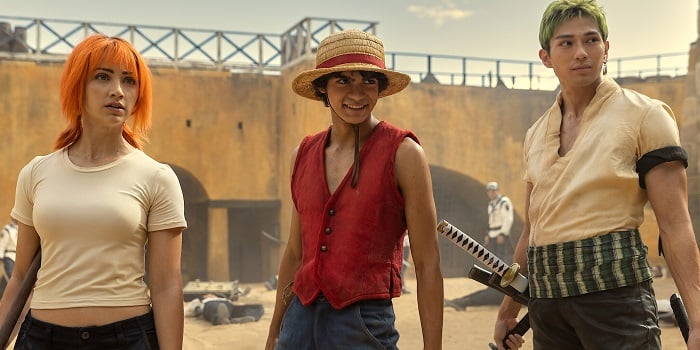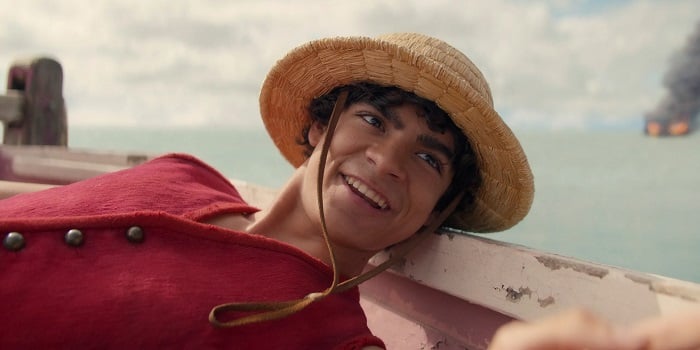It won’t be wrong to call the year 2023 the year of live-action adaptations — think The Last of Us, Yu Yu Hakusho, One Piece, and Five Nights at Freddy’s, among others. However, One Piece, in particular, was not only a live-action adaptation that was difficult to put in motion for creators but it was almost impossible for audiences to imagine how the show would look prior to its trailers. Questions like — who will play Monkey D. Luffy? How will the showrunners present his elastic powers? How can they set up somebody to play Arlong? But surprisingly, it all worked out wonderfully — the hard work of the creative team, cast, and showrunners was evident as soon as the trailers came out.
Netflix’s One Piece live-action was received so well that it got greenlit for a season 2 right away! The show currently has 8.4 ratings on IMDB and enjoys an 85% Tomatometer score at Rotten Tomatoes. So how exactly did this live-action adaptation click so well with the audiences? These three reasons detail a spot-on analysis of what actually made Netflix’s One Piece a sure shot.
The Castings in One Piece Were Spot-On

The casting of One Piece was a critical factor in its success, as it brought to life the cherished characters from the original manga and anime. The way Iñaki Godoy played Monkey D. Luffy was a highlight! He perfectly captured the adventurous spirit, unwavering determination, carelessness, and charisma, that was required to play Luffy — Godoy made it look effortless!
One of the primary antagonists, Arlong, was brought to life by McKinley Belcher III. To say that he perfectly played the ruthless fisherman and ruler of Arlong Park, with his very tangible sense of danger, would be an understatement. Not to forget Jeff Ward pulling off a masterclass with Buggy!
Sanji, played by Taz Skylar, was another well-received casting. Sanji’s sophisticated demeanor, his exceptional culinary skills, and his complex backstory, including his relationship with Chef Zeff (Craig Fairbrass), were done beautifully! Other characters, like Nami (Emily Rudd), Usopp (Jacob Gibson), and Zoro (Mackenyu), were equally well-cast, with each actor bringing out the unique traits that fans adore. Nami’s intelligence and cunning, Usopp’s blend of humor and bravery, and Zoro’s stoic and skilled swordsman persona were all effectively portrayed by the cast.
The Pacing of the Show Was Well Done


Adapting One Piece into a live-action series was a monumental task considering the scale of the source material. The One Piece manga, started by Eiichiro Oda in 1997, has amassed over 100 volumes, making it one of the longest-running and most expansive manga series ever. The anime adaptation, which began in 1999, has over 1000 episodes spread across multiple seasons, each detailing the adventures of Monkey D. Luffy and his crew. This vast narrative includes a plethora of characters, intricate plotlines, and a detailed world that spans various islands and seas.
Translating all that into a live-action series required converting the whole story into a more condensed format. To be able to fit a number of events from manga/anime into just eight episodes was a feat in itself. The creators had to decide which arcs and characters were essential for the narrative continuity and which could be omitted or altered without losing the core of One Piece. A notable decision in the adaptation process was how they handled the introduction of the Straw Hat Pirates crew relatively earlier. In the manga and anime, the crew members are introduced gradually over several arcs.
Plus, the live-action series had to expedite this process due to the limited number of episodes. As a result, the creators also focused on introducing the core characters like Luffy, Zoro, Nami, Usopp, and Sanji in a much more condensed timeline. Another example is the handling of the antagonists. In the anime and manga, villains like Buggy the Clown and Captain Kuro are given substantial screen time, with detailed backstories that intertwine. For the live-action series, the creators had to balance the need to present these villains as credible threats while also streamlining their stories to fit the series’ pacing in a rather limited eight-episode format — and it was still well done!
The Netflix ‘One Piece’ Storyline Remained Largely Faithful to Manga and Anime


Despite the challenges of condensing the lore of One Piece into an eight-episode live-action series, the creators succeeded in keeping the storyline largely faithful to Oda’s manga and the subsequent anime adaptation. This fidelity to the source material was crucial in appealing to the dedicated fanbase of One Piece — whose nod became one of the major reasons behind its success.
The central plotlines, key character arcs, and the overarching themes of adventure, friendship, and the pursuit of dreams remained intact. The live-action series managed to present Monkey D. Luffy’s quest to become the Pirate King and his formation of the Straw Hat Pirates just right. Important plot points, such as Luffy’s acquisition of his Devil Fruit powers and the early adversities faced by the crew, were retained and skillfully adapted for live-action. Except for a few parts that were either differently arranged or some details that were skipped to maintain pacing, the overall story was very well structured. Interestingly, after the show’s success, another One Piece anime is now in the works at Netflix.
